1. Which of the following statements are appropriate to Mangrove Sites?
- Mangrove plants require an appropriate mix of saline water and freshwater.
- Mangrove plants require mudflats to enable it to grow and develop.
- Mangrove plants are found in the inter-tidal zones of sheltered coasts.
- Mangrove vegetation has been reported in all the coastal States including Andaman and Nicobar Islands.
Select the correct answer using the code given below:
- 1 and 2 only
- 1, 3 and 4 only
- 2, 3 and 4 only
- 1, 2, 3 and 4
2. Consider the following statements regarding Millet
- Millets have a high glycemic index.
- There are nine types of millet grown in India.
- India is the highest producer of millets in the globe and the 5th largest exporter of millets.
Which of the above statements is true?
- 1 & 2 only
- 1 & 3 only
- 2 & 3 only
- 3 only
3. Consider the following animals: (2013)
- Sea cow
- Sea horse
- Sea lion
Which of the above is/are mammal/mammals?
- 1 only
- 1 and 3 only
- 2 and 3 only
- 1, 2 and 3
4. Consider the following statements about the Horseshoe Crab recently seen in the news
- They are found only in the Indian Ocean.
- Tamil Nadu has the highest population of the Horseshoe Crab.
- Their blue blood contains Limulus amebocyte lysate (LAL) which has medicinal significance.
Which of the above statements is true?
- 1 & 2 only
- 1 & 3 only
- 2 & 3 only
- 3 only
5. Recently, Barda Wildlife sanctuary was in the news for being in consideration for the second home to Asiatic lions.
It is in which of the following states?
- Rajasthan
- Madhya Pradesh
- Gujarat
- None of the above.
Answers with Explanations
1. Which of the following statements are appropriate to Mangrove Sites?
- Mangrove plants require an appropriate mix of saline water and freshwater.
- Mangrove plants require mudflats to enable it to grow and develop.
- Mangrove plants are found in the inter-tidal zones of sheltered coasts.
- Mangrove vegetation has been reported in all the coastal States including Andaman and Nicobar Islands.
Select the correct answer using the code given below:
- 1 and 2 only
- 1, 3 and 4 only
- 2, 3 and 4 only
- 1, 2, 3 and 4
Answer: 3
Explanation
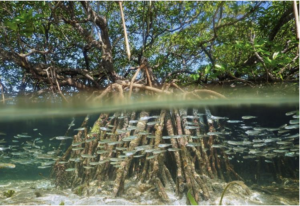
- Mangroves represent a characteristic littoral (near the sea shore) forest ecosystem.
- These are mostly evergreen forests that grow in sheltered low lying coasts, estuaries, mudflats, tidal creeks backwaters (coastal waters held back on land), marshes and lagoons of tropical and subtropical regions.
- They are referred to as ‘tidal forests’ and belong to the category of ‘tropical wetland rainforest ecosystem’.
- Mangroves are highly productive ecosystems.
- They protect the shoreline from the effect of cyclones and tsunamis.
- They are among the first lines of defense against incoming cyclones, storm surges and wind shear and more than proved their worth during the devastating Asian tsunami of 2004.
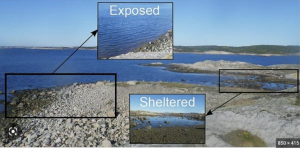
- Mangrove forests are known to capture massive amounts of carbon and sequester (trap and store) it for millennia.
- They serve as breeding, feeding and nursery grounds for most of the commercial fishes and crustaceans on which thousands of people depend for their livelihood.
- Since mangroves are located between the land and sea, they represent the best example of ecotone.
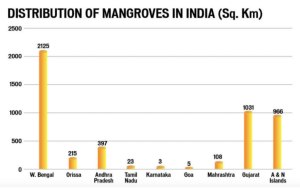
2. Consider the following statements regarding Millet
- Millets have a high glycemic index.
- There are nine types of millet grown in India.
- India is the highest producer of millets in the globe and the 5th largest exporter of millets.
Which of the above statements is true?
- 1 & 2 only
- 1 & 3 only
- 2 & 3 only
- 3 only
Answer: 3
Explanation
- ‘Millets’ were among the first crops to be domesticated in India with several evidence of its consumption during the Indus valley civilization.
- In India, millets are primarily a kharif crop(Monsson/Autumn crops – July to November), requiring less water and agricultural inputs than other similar staples.
- Millets are a group of small-seeded annual grasses that are grown as grain crops primarily on marginal land in dry areas and belong to the Poaceae family.
- The sudden global fame of this coarse grain can be traced back to March 2021, when the United Nations (UN) General Assembly at its 75th session declared 2023 the International Year of Millets (IYM2023).
- They are hardy, salinity-tolerant, and can grow in drought-prone environments with poor soils, even in temperatures up to 50 degrees Celsius, they minimise the risk to farmers and communities.
Health Benefits
- Millets have a low glycemic index which helps in diabetes management.
- The high fiber content in millets acts as pre-biotics and thus helps to maintain a healthy gut microbiome.
- Millets are absolutely gluten-free and it is good for celiac patients.
- Millets are rich in antioxidants which protect our cells from free radicals.
Millet production in India
- There are nine types of Millet grown in India.
- The major millets are Sorghum, Pearl Millet and Finger Millet covering 95% of the total millet growing area in India
- The rest 5% are Little Millet, Foxtail Millet, Barnyard Millet, Proso Millet, Kodo Millet, and Browntop Millet.
- India is the highest producer of millets in the globe and the 5th largest exporter of millets.
- In 2020, the millet production in India was 28 million metric tons.
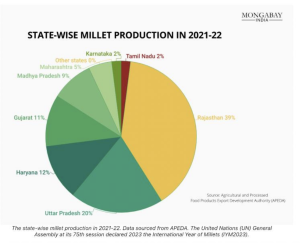
3. Consider the following animals: (2013)
- Sea cow
- Sea horse
- Sea lion
Which of the above is/are mammal/mammals?
- 1 only
- 1 and 3 only
- 2 and 3 only
- 1, 2 and 3
Answer: 2
Explanation
- Seahorses are tiny fishes that are named for the shape of their head, which looks like the head of a tiny horse. There are at least 50 species of seahorses.
- They are classified as fish, in the genus Hippocampus.
- Seahorses are found in shallow coastal waters in latitudes from about 52° N to 45° S.
- Their habitats include coral reefs, mangroves, sea grass beds, and estuaries.
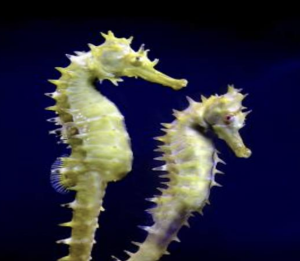
Seahorses in India
- The coastal ecosystems of India house nine out of 12 species found in the Indo-Pacific.
- It is distributed across diverse ecosystems such as seagrass, mangroves, macroalgal beds, and coral reefs.
- These nine species are distributed along the coasts of eight States and five Union Territories from Gujarat to Odisha, apart from Lakshadweep and the Andaman and Nicobar Islands.
- Great Seahorse is one of the species of seahorses found in India
- The Great Seahorse is declared ‘Vulnerable’ as its population is declining due to overexploitation.
- It is used in Chinese medicine as well as for ornamental purposes.
- Destructive fishing methods are also causing damage to the Great Seahorses.
- The species is abundant off the Coromandel coast (Andhra Pradesh and Tamil Nadu)
- The seahorse it is under extensive fishing pressure, with 13 million individuals caught per year.
4. Consider the following statements about the Horseshoe Crab recently seen in the news
- They are found only in the Indian Ocean.
- Tamil Nadu has the highest population of the Horseshoe Crab.
- Their blue blood contains Limulus amebocyte lysate (LAL) which has medicinal significance.
Which of the above statements is true?
- 1 & 2 only
- 1 & 3 only
- 2 & 3 only
- 3 only
Answer : 4
Explanation
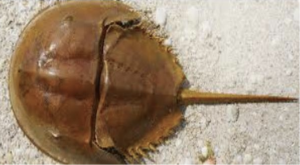
- Scientists raise alarm over the decline in horseshoe crab population along Odisha coast.
- Horseshoe crabs migrate to the coasts of Odisha for breeding.
- However, scientists are now raising the alarm over the declining population of these crabs due to the loss of breeding grounds and environmental degradation.
- The horseshoe crab is a marine chelicerate arthropod living in shallow coastal waters on soft sandy or muddy bottoms.
- Despite their name, they are not true crabs or crustaceans, they are chelicerates, most closely related to arachnids such as spiders, ticks, and scorpions.
- The Horseshoe crabs have been around for over 450 million years.
- Hence they are also called as ‘living fossil’
- They are commonly found in shallow ocean waters along the coasts of North America and Asia.
- Horseshoe crabs live up to 20 years or more.
Conservation Status –
India
- Wildlife Protection Act 1972: Schedule IV
IUCN Status
- American horseshoe crab: Vulnerable
- Tri-spine horseshoe crab: Endangered
Significance of horseshoe crabs
- Horseshoe crabs are one of the oldest living creatures on the planet
- They play a vital role in medical research, especially in the development of vaccines and drugs.
- Their blue blood contains a chemical called Limulus amebocyte lysate (LAL), which is used to detect bacterial endotoxins in medicines and medical devices.
- This chemical has also been used to test for the presence of pathogens in COVID-19 vaccines.
- The conservation of horseshoe crabs is crucial for their ecological significance.
- It is also important for the medical industry.
- The global demand for LAL has been increasing in recent years.
- The horseshoe crab population’s decline could have significant implications for medical research.
5. Recently, Barda Wildlife sanctuary was in the news for being in consideration for the second home to Asiatic lions.
It is in which of the following states?
- Rajasthan
- Madhya Pradesh
- Gujarat
- None of the above.
Answer: 3
Explanation
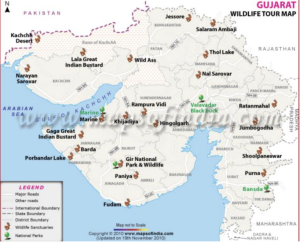
- The Gir National Park and Wildlife Sanctuary in Gujarat are known as the last refuge of the Asiatic lion.
- Increased population has caused overcrowding.
- This has prompted the Gujarat government to look for a alterative sites for the lions.
- In a recent move, the government has decided to shift 40 lions from Gir to the nearby Barda Wildlife Sanctuary.
- Barda Wildlife Sanctuary is located in Porbandar district of Gujarat, about 100 km west of Gir Forest National Park.
- It covers an area of 192 square kilometers.
- It is a dry deciduous forest with rugged terrain, consisting of hills, plateaus, and valleys.
- Two rivers Bileshvary River and Joghri River flow through the sanctuary.
- The sanctuary is home to a variety of wildlife, including leopards, hyenas, wild boars, and Indian pangolins
➡️UPSC 2023 General Studies Course: https://sleepyclasses.com/general-studies-for-upsc/
➡️Sociology Optional for UPSC: https://sleepyclasses.com/sociology-for-upsc/
➡️Political Science and IR for UPSC: https://sleepyclasses.com/psir-for-upsc/
➡️Signup here – https://sleepyclasses.com/
Have any query related to UPSC preparation: 📞Contact Us ► Toll-Free: 1800 890 3043 ► Mobile: 6280133177 ► Email: Sleepy.Classes@gmail.com ► WhatsApp: 6280133177



